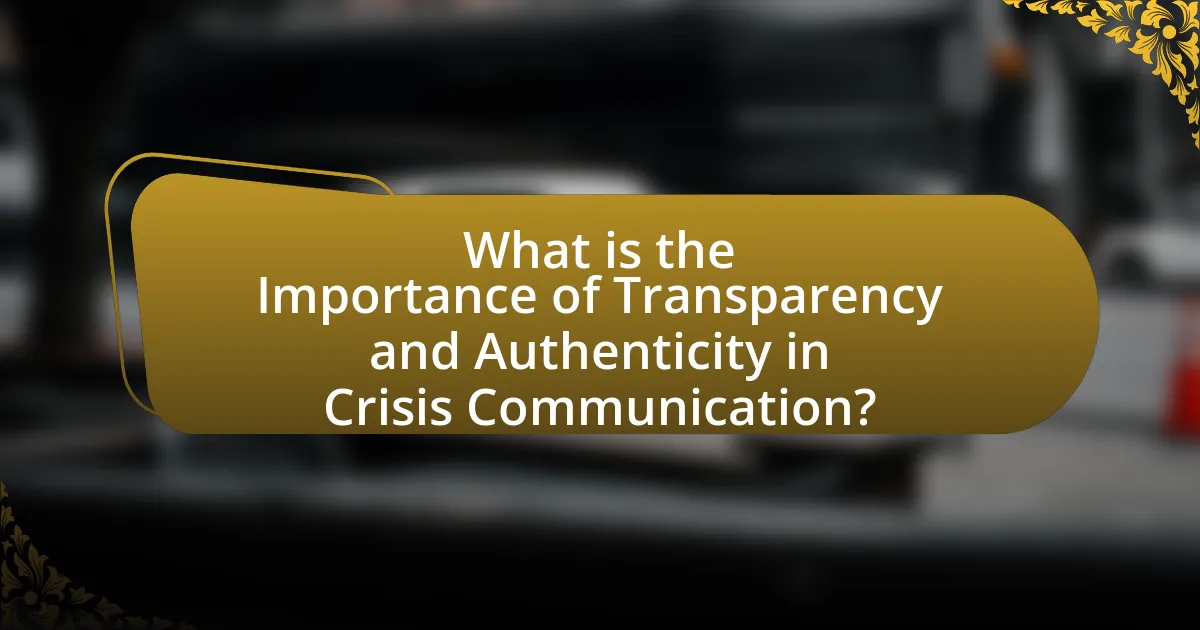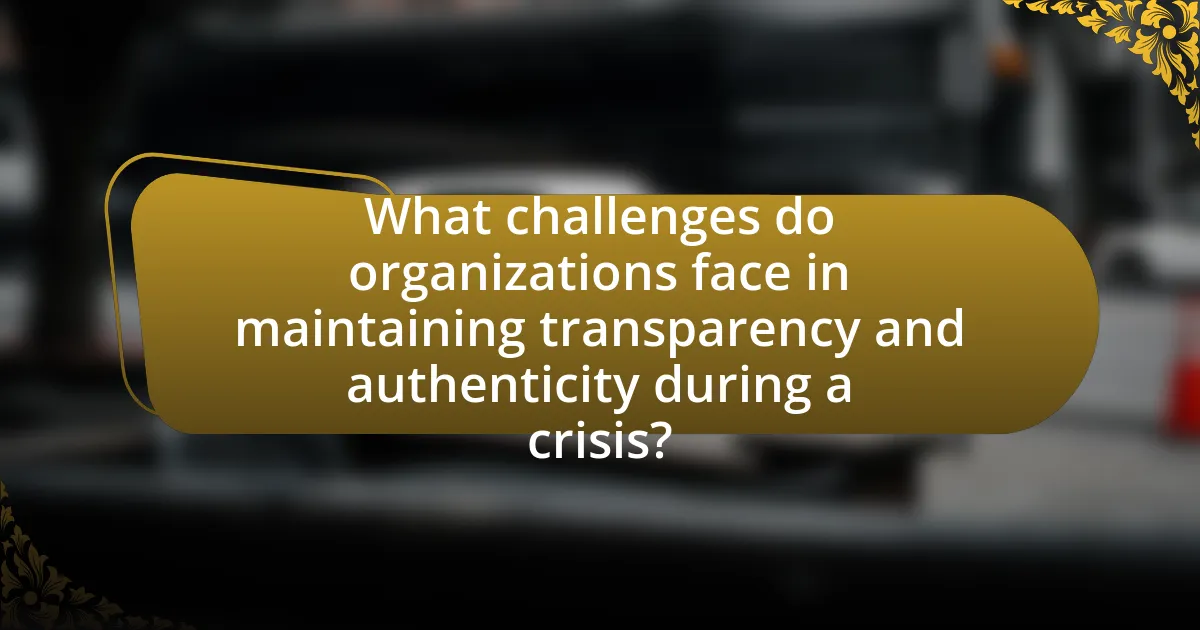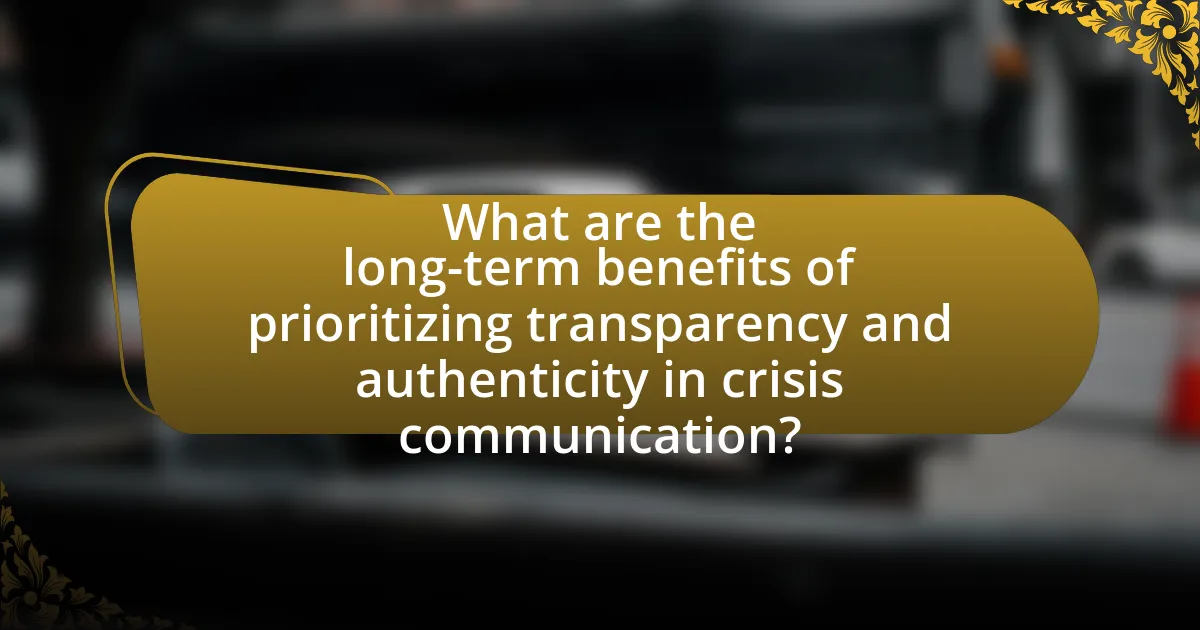The article focuses on the significance of transparency and authenticity in crisis communication, emphasizing their role in building trust and credibility with stakeholders. It outlines how open and honest communication can mitigate reputational damage, enhance stakeholder loyalty, and improve public perception during crises. Key elements of effective crisis communication, such as timely information dissemination and audience engagement, are discussed, along with strategies to maintain transparency and authenticity. The article also highlights common challenges organizations face in achieving these goals and provides practical tips for enhancing communication practices during crises.

What is the Importance of Transparency and Authenticity in Crisis Communication?
Transparency and authenticity are crucial in crisis communication as they build trust and credibility with stakeholders. When organizations communicate openly about challenges and provide honest updates, they foster a sense of reliability, which is essential during uncertain times. Research indicates that 70% of consumers are more likely to trust a brand that is transparent about its operations and challenges (Edelman Trust Barometer, 2021). This trust can mitigate reputational damage and enhance stakeholder loyalty, ultimately leading to a more effective crisis resolution.
Why are transparency and authenticity critical during a crisis?
Transparency and authenticity are critical during a crisis because they foster trust and credibility between organizations and their stakeholders. When organizations communicate openly about the situation, including challenges and uncertainties, they demonstrate accountability, which is essential for maintaining public confidence. Research by the Institute for Public Relations indicates that transparent communication can significantly reduce misinformation and speculation, which often proliferate during crises. Furthermore, authentic messaging that reflects the true values and intentions of an organization can strengthen relationships and encourage cooperation from stakeholders, ultimately leading to more effective crisis management.
How do transparency and authenticity influence public perception?
Transparency and authenticity significantly enhance public perception by fostering trust and credibility. When organizations communicate openly about their actions and intentions, they create an environment where stakeholders feel valued and informed. Research indicates that 81% of consumers prefer to buy from brands they trust, highlighting the direct correlation between transparent practices and positive public sentiment. Furthermore, authenticity in messaging resonates with audiences, as it reflects genuine values and commitments, leading to stronger emotional connections. This is supported by a study from the Harvard Business Review, which found that companies perceived as authentic are more likely to retain customer loyalty during crises. Thus, transparency and authenticity are crucial in shaping favorable public perception.
What role do they play in building trust with stakeholders?
Transparency and authenticity play a crucial role in building trust with stakeholders by fostering open communication and demonstrating accountability. When organizations communicate transparently during crises, they provide stakeholders with accurate information, which reduces uncertainty and builds confidence. For instance, a study by the Institute for Public Relations found that organizations that practice transparency are perceived as more trustworthy, leading to stronger stakeholder relationships. This trust is essential for maintaining loyalty and support, especially in challenging times.
What are the key elements of effective crisis communication?
The key elements of effective crisis communication include transparency, authenticity, timely information dissemination, and audience engagement. Transparency ensures that stakeholders receive clear and honest information about the crisis, which builds trust. Authenticity involves conveying messages that reflect the organization’s true values and intentions, fostering credibility. Timely information dissemination is crucial, as it helps to prevent misinformation and keeps the audience informed about developments. Audience engagement allows organizations to address concerns and questions directly, enhancing the overall communication process. These elements are supported by research indicating that organizations that prioritize transparency and authenticity during crises are more likely to maintain public trust and mitigate reputational damage.
How does clear messaging contribute to transparency?
Clear messaging enhances transparency by ensuring that information is conveyed in an understandable and straightforward manner. When organizations communicate clearly, stakeholders can easily grasp the intentions, actions, and implications of decisions, which fosters trust and accountability. Research indicates that transparent communication practices, such as using plain language and avoiding jargon, significantly improve stakeholder engagement and perception of credibility. For instance, a study by the Institute for Public Relations found that organizations that prioritize clear messaging during crises are perceived as more trustworthy, leading to better stakeholder relationships and reduced misinformation.
What strategies enhance authenticity in communication?
Strategies that enhance authenticity in communication include active listening, transparency, and consistent messaging. Active listening fosters genuine engagement, allowing communicators to understand and respond to the needs and concerns of their audience effectively. Transparency involves sharing relevant information openly, which builds trust and credibility; for instance, organizations that disclose challenges during a crisis are often perceived as more trustworthy. Consistent messaging ensures that the information conveyed aligns with the organization’s values and previous communications, reinforcing authenticity. Research by the Institute for Public Relations indicates that transparent communication significantly improves stakeholder trust during crises, highlighting the effectiveness of these strategies.
How can organizations implement transparency and authenticity in their crisis communication plans?
Organizations can implement transparency and authenticity in their crisis communication plans by establishing clear communication protocols that prioritize timely and accurate information sharing. This involves creating a dedicated crisis communication team responsible for monitoring situations and disseminating updates to stakeholders. For instance, during the COVID-19 pandemic, organizations that provided regular updates and openly addressed uncertainties were more trusted by their audiences, as evidenced by a study from the Pew Research Center showing that transparency increased public trust in organizations. Additionally, organizations should encourage two-way communication, allowing stakeholders to voice concerns and ask questions, which fosters a sense of involvement and trust. By integrating these practices, organizations can enhance their credibility and maintain stakeholder confidence during crises.
What best practices should be followed for transparent communication?
Best practices for transparent communication include providing clear, honest information, actively listening to stakeholders, and maintaining consistency in messaging. Clear and honest information fosters trust, as evidenced by a study from the Institute for Public Relations, which found that organizations perceived as transparent are more likely to maintain positive relationships during crises. Actively listening to stakeholders allows organizations to address concerns and adapt messages accordingly, enhancing engagement. Consistency in messaging prevents confusion and reinforces credibility, as demonstrated by research from the Harvard Business Review, which highlights that inconsistent communication can lead to distrust and misinformation.
How can organizations ensure their messages are authentic?
Organizations can ensure their messages are authentic by prioritizing transparency and aligning their communications with their core values. This involves openly sharing information, acknowledging mistakes, and providing clear, consistent messaging that reflects the organization’s mission and principles. Research indicates that 86% of consumers consider authenticity important when deciding what brands they like and support, highlighting the necessity for organizations to maintain credibility through honest communication.

What challenges do organizations face in maintaining transparency and authenticity during a crisis?
Organizations face significant challenges in maintaining transparency and authenticity during a crisis, primarily due to the pressure to control narratives and manage public perception. This pressure often leads to withholding information or providing incomplete data, which can erode trust. For instance, a study by the Institute for Public Relations found that 70% of consumers expect organizations to be transparent during crises, yet many organizations struggle to balance this expectation with the need to protect sensitive information. Additionally, the rapid spread of misinformation on social media complicates efforts to communicate effectively, as organizations must respond quickly while ensuring accuracy. These factors collectively hinder the ability of organizations to uphold transparency and authenticity, ultimately impacting their credibility and stakeholder relationships.
What common pitfalls lead to a lack of transparency?
Common pitfalls that lead to a lack of transparency include inadequate communication, information withholding, and failure to engage stakeholders. Inadequate communication occurs when organizations do not provide clear, timely updates, resulting in confusion and mistrust. Information withholding happens when critical details are intentionally kept from the public, which can exacerbate crises and damage credibility. Additionally, failure to engage stakeholders, such as employees, customers, and the community, can create a disconnect, leading to perceptions of secrecy and a lack of accountability. These pitfalls are supported by research indicating that organizations that prioritize open communication and stakeholder engagement are more likely to maintain trust during crises.
How can misinformation impact crisis communication efforts?
Misinformation can severely undermine crisis communication efforts by creating confusion and eroding public trust. When inaccurate information spreads, it can lead to misinterpretations of the situation, causing individuals to react inappropriately or make decisions based on false premises. For example, during the COVID-19 pandemic, misinformation about the virus’s transmission and prevention methods led to widespread panic and non-compliance with health guidelines, as reported by the World Health Organization. This illustrates how misinformation not only complicates the dissemination of accurate information but also hampers effective crisis management by diverting attention from credible sources and solutions.
What are the consequences of failing to be authentic?
Failing to be authentic can lead to a breakdown of trust between individuals and organizations. When authenticity is compromised, stakeholders may perceive communications as insincere, resulting in skepticism and disengagement. Research indicates that 81% of consumers need to trust a brand before making a purchase, highlighting the critical role of authenticity in maintaining relationships. Additionally, a lack of authenticity can damage reputations, as seen in cases where organizations faced backlash for misleading information during crises, leading to long-term financial and relational repercussions.
How can organizations overcome these challenges?
Organizations can overcome challenges in crisis communication by implementing clear and consistent messaging. This involves establishing a communication plan that prioritizes transparency and authenticity, ensuring that stakeholders receive accurate information promptly. Research indicates that organizations that communicate openly during crises can maintain trust and credibility; for example, a study by the Institute for Public Relations found that transparent communication can enhance stakeholder relationships and mitigate reputational damage. By actively engaging with their audience and addressing concerns directly, organizations can foster a sense of reliability and support during challenging times.
What tools and resources can aid in maintaining transparency?
Tools and resources that aid in maintaining transparency include communication platforms, data visualization tools, and transparency frameworks. Communication platforms like Slack or Microsoft Teams facilitate open dialogue among stakeholders, ensuring that information flows freely and is accessible. Data visualization tools such as Tableau or Google Data Studio help present complex data in an understandable format, making it easier for audiences to grasp key insights. Transparency frameworks, like the Open Government Partnership, provide guidelines and best practices for organizations to follow, promoting accountability and openness. These tools collectively enhance the ability to share information clearly and effectively, fostering trust during crises.
How can training improve authenticity in crisis communication?
Training can improve authenticity in crisis communication by equipping communicators with the skills to convey messages transparently and empathetically. Effective training programs focus on developing key competencies such as active listening, emotional intelligence, and clear messaging, which are essential for building trust during a crisis. Research indicates that organizations with trained crisis communicators are more likely to maintain credibility and foster positive relationships with stakeholders, as they can respond to concerns with sincerity and clarity. For instance, a study by Coombs and Holladay (2012) highlights that organizations that prioritize training in crisis communication experience a 30% increase in stakeholder trust compared to those that do not.

What are the long-term benefits of prioritizing transparency and authenticity in crisis communication?
Prioritizing transparency and authenticity in crisis communication leads to enhanced trust and credibility over time. Organizations that communicate openly during crises are more likely to maintain positive relationships with stakeholders, as evidenced by a study from the Institute for Public Relations, which found that transparent communication significantly improves public perception and trust. Furthermore, consistent authenticity fosters loyalty among customers and employees, as they feel valued and respected, leading to long-term engagement and support. This approach not only mitigates reputational damage during crises but also positions organizations favorably for future challenges, as stakeholders are more likely to rally behind a brand they trust.
How does transparency contribute to organizational resilience?
Transparency enhances organizational resilience by fostering trust and facilitating effective communication during crises. When organizations are transparent, stakeholders, including employees and customers, are more likely to feel informed and engaged, which strengthens their commitment and loyalty. Research indicates that organizations that prioritize transparency experience quicker recovery from crises, as seen in a study by the Harvard Business Review, which found that transparent communication leads to a 25% increase in employee engagement during challenging times. This engagement is crucial for maintaining operational continuity and adaptability, ultimately contributing to the organization’s ability to withstand and recover from disruptions.
What impact does authenticity have on stakeholder loyalty?
Authenticity significantly enhances stakeholder loyalty by fostering trust and emotional connection. When organizations demonstrate genuine values and transparency, stakeholders are more likely to feel aligned with the organization’s mission and vision. Research indicates that 81% of consumers prefer to buy from companies that share their values, highlighting the importance of authenticity in building lasting relationships. Furthermore, a study published in the Journal of Business Ethics found that authentic communication during crises leads to increased stakeholder trust, which directly correlates with loyalty. Thus, authenticity serves as a critical factor in cultivating and maintaining stakeholder loyalty.
What lessons can be learned from successful crisis communication examples?
Successful crisis communication examples demonstrate that transparency and authenticity are crucial for maintaining trust and credibility. Organizations that openly share information about the crisis, such as Johnson & Johnson during the Tylenol poisoning incident in 1982, effectively managed public concern by promptly recalling products and communicating directly with consumers. This approach not only mitigated damage but also reinforced the brand’s commitment to safety. Furthermore, authentic messaging that reflects genuine concern, as seen in the response of companies like Starbucks during racial bias incidents, fosters a connection with stakeholders and enhances reputation. These examples illustrate that clear, honest communication can lead to positive outcomes even in challenging situations.
Which case studies highlight the importance of transparency and authenticity?
Case studies that highlight the importance of transparency and authenticity include the Johnson & Johnson Tylenol crisis in 1982 and the Starbucks racial bias incident in 2018. In the Tylenol case, the company immediately recalled 31 million bottles of Tylenol after reports of tampering, demonstrating transparency and prioritizing consumer safety, which ultimately restored public trust. In the Starbucks incident, the company publicly acknowledged the racial bias incident involving two Black men being arrested in a store, closed stores for racial bias training, and communicated openly about their commitment to inclusivity, reinforcing their brand authenticity. Both cases illustrate how transparent and authentic communication can effectively manage crises and maintain consumer trust.
What strategies were effective in these successful examples?
Effective strategies in successful examples of crisis communication include maintaining open lines of communication, providing timely updates, and demonstrating empathy. Open communication fosters trust, as seen in organizations that promptly addressed concerns during crises, allowing stakeholders to feel informed and valued. Timely updates are crucial; for instance, companies that regularly shared information during a crisis were able to mitigate misinformation and maintain credibility. Demonstrating empathy, as evidenced by leaders who acknowledged the emotional impact of crises on affected individuals, helped to humanize the response and strengthen community ties. These strategies collectively enhance transparency and authenticity, which are vital in crisis situations.
What practical tips can organizations follow to enhance transparency and authenticity in crisis communication?
Organizations can enhance transparency and authenticity in crisis communication by implementing clear and consistent messaging. This involves providing timely updates to stakeholders, ensuring that information is accurate and straightforward, and avoiding jargon that may confuse the audience. Additionally, organizations should encourage open dialogue by inviting questions and feedback, which fosters trust and demonstrates a commitment to transparency.
Research indicates that companies that communicate openly during crises are perceived as more trustworthy; for instance, a study by the Institute for Public Relations found that transparency significantly influences public perception and can mitigate reputational damage. By prioritizing these practices, organizations can effectively navigate crises while maintaining credibility and trust with their audiences.

Leave a Reply